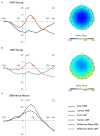Error-Related Cognitive Control and Behavioral Adaptation Mechanisms in the Context of Motor Functioning and Anxiety
- PMID: 33613211
- PMCID: PMC7892788
- DOI: 10.3389/fnhum.2021.615616
Error-Related Cognitive Control and Behavioral Adaptation Mechanisms in the Context of Motor Functioning and Anxiety
Abstract
Motor proficiency reflects the ability to perform precise and coordinated movements in different contexts. Previous research suggests that different profiles of motor proficiency may be associated with different cognitive functioning characteristics thus suggesting an interaction between cognitive and motor processes. The current study investigated this interaction in the general population of healthy adults with different profiles of motor proficiency by focusing on error-related cognitive control and behavioral adaptation mechanisms. In addition, the impact of these processes was assessed in terms of trait anxiety and worries. Forty healthy adults were divided into high and low motor proficiency groups based on an assessment of their motor skills. Using electroencephalography during a flanker task, error-related negativity (ERN) was measured as the neural indicator of cognitive control. Post-error slowing (PES) was measured to represent behavioral adaptation. Participants also completed an anxiety assessment questionnaire. Participants in the high motor proficiency group achieved better task accuracy and showed relatively enhanced cognitive control through increased ERN. Contrastingly, individuals in the lower motor proficiency group achieved poorer accuracy whilst showing some evidence of compensation through increased PES. Trait anxiety reflecting general worries was found to be correlated with motor functioning, but the study could not provide evidence that this was related to cognitive or behavioral control mechanisms. The interaction between cognitive and motor processes observed in this study is unique for healthy and sub-clinical populations and provides a baseline for the interpretation of similar investigations in individuals with motor disorders.
Keywords: anxiety; behavioral adaptation; cognitive control; error-related negativity; motor skills; post-error slowing.
Copyright © 2021 Topor, Opitz and Leonard.
Conflict of interest statement
The authors declare that the research was conducted in the absence of any commercial or financial relationships that could be construed as a potential conflict of interest.
Figures





Similar articles
-
Cognitive control in adults with high-functioning autism spectrum disorder: a study with event-related potentials.Front Psychiatry. 2023 Aug 4;14:1180827. doi: 10.3389/fpsyt.2023.1180827. eCollection 2023. Front Psychiatry. 2023. PMID: 37599885 Free PMC article.
-
Error-related brain activity in youth and young adults before and after treatment for generalized or social anxiety disorder.Prog Neuropsychopharmacol Biol Psychiatry. 2016 Nov 3;71:162-8. doi: 10.1016/j.pnpbp.2016.07.010. Epub 2016 Aug 2. Prog Neuropsychopharmacol Biol Psychiatry. 2016. PMID: 27495356 Free PMC article.
-
Cognitive control adjustments in healthy older and younger adults: Conflict adaptation, the error-related negativity (ERN), and evidence of generalized decline with age.Biol Psychol. 2016 Mar;115:50-63. doi: 10.1016/j.biopsycho.2016.01.008. Epub 2016 Jan 21. Biol Psychol. 2016. PMID: 26802364
-
The ERN as a neural index of changes in performance monitoring following attention training in pediatric obsessive-compulsive disorder.Biol Psychol. 2021 Nov;166:108206. doi: 10.1016/j.biopsycho.2021.108206. Epub 2021 Oct 15. Biol Psychol. 2021. PMID: 34662675 Review.
-
On the relationship between the error-related negativity and anxiety in children and adolescents: From a neural marker to a novel target for intervention.Psychophysiology. 2022 Jun;59(6):e14050. doi: 10.1111/psyp.14050. Epub 2022 Mar 24. Psychophysiology. 2022. PMID: 35324015 Review.
Cited by
-
Anxiety disrupts performance monitoring: integrating behavioral, event-related potential, EEG microstate, and sLORETA evidence.Cereb Cortex. 2023 Mar 21;33(7):3787-3802. doi: 10.1093/cercor/bhac307. Cereb Cortex. 2023. PMID: 35989310 Free PMC article.
-
Post-error Slowing Reflects the Joint Impact of Adaptive and Maladaptive Processes During Decision Making.Front Hum Neurosci. 2022 Jun 9;16:864590. doi: 10.3389/fnhum.2022.864590. eCollection 2022. Front Hum Neurosci. 2022. PMID: 35754776 Free PMC article.
-
Post-error adjustments occur in both reaching and grasping.Exp Brain Res. 2024 Jun;242(6):1495-1505. doi: 10.1007/s00221-024-06836-5. Epub 2024 May 5. Exp Brain Res. 2024. PMID: 38704771
-
Psychometrics of drift-diffusion model parameters derived from the Eriksen flanker task: Reliability and validity in two independent samples.Cogn Affect Behav Neurosci. 2025 Apr;25(2):311-328. doi: 10.3758/s13415-024-01222-8. Epub 2024 Oct 23. Cogn Affect Behav Neurosci. 2025. PMID: 39443415 Free PMC article.
-
In search for the most optimal EEG method: A practical evaluation of a water-based electrode EEG system.Brain Neurosci Adv. 2021 Oct 26;5:23982128211053698. doi: 10.1177/23982128211053698. eCollection 2021 Jan-Dec. Brain Neurosci Adv. 2021. PMID: 34722932 Free PMC article.
References
-
- Brain Products (2012). BrainVision Recorder & Analyzer 2.1.1. Gilching: Brain Products.
LinkOut - more resources
Full Text Sources
Other Literature Sources

